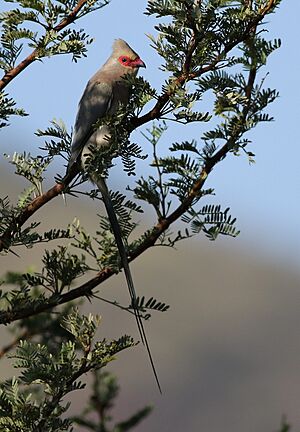Red-faced mousebird facts for kids
Quick facts for kids Red-faced mousebird |
|
|---|---|
 |
|
| Conservation status | |
| Scientific classification | |
| Genus: |
Urocolius
|
| Species: |
indicus
|
The red-faced mousebird (Urocolius indicus) is a special type of bird called a mousebird. It's quite common in southern Africa. You can find it from the Democratic Republic of Congo and Tanzania all the way south to the Cape. These birds love living in savannas with thick bushes, open woodlands, gardens, and even fruit orchards.
Contents
What Does It Look Like?
This bird is about 34 centimeters (13 inches) long. Its tail makes up about half of its total length! It has a cool crest on its head. The head and chest are a pale cinnamon color. Its bill and the area around its eyes are bright red, like a mask.
The rest of its upper body and tail are blue-grey. Its lower back (rump) is a lighter grey. The belly is whitish. Both male and female red-faced mousebirds look very similar. Young birds, called juveniles, don't have the crest. They also have a green mask instead of a red one. Their call sounds like a tree-ree-ree whistle. They often repeat this call many times, whether they are flying or sitting still.
What Do They Eat?
Red-faced mousebirds are mostly fruit-eaters, also known as frugivores. They love to munch on all sorts of fruits and berries. They also eat leaves, seeds, and sweet nectar. When they fly from one feeding spot to another, they are usually very fast and fly in a straight line.
How Do They Live Together?
Outside of the breeding season, these birds are very social. They like to feed together in small groups. Usually, you'll see about six birds together. Sometimes, though, groups can have 15 or more! They fly and interact very closely. They even preen each other's feathers, which is like helping a friend tidy up. At night, they roost (sleep) together in groups. They are a bit more cautious than other types of mousebirds.
Reproduction and Life Cycle
These birds don't move around much; they stay in one area. They usually breed between June and February. Their nest is a big, messy cup made of plant materials. They line it with soft things like sheep wool to make it cozy.
A female red-faced mousebird lays between 2 and 6 eggs. The eggs are creamy white with reddish-brown spots. The eggs hatch in about two weeks.
Images for kids






